Hyundai Santa
Fe Front Brake Pads Replacement Guide
How to replace the front brake pads on a
2007 to 2012 Hyundai Santa Fe SUV with picture illustrated instructions.
By Paul B. Michaels Author & Photographer Auto Mechanic Since 1989 |
||
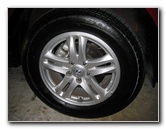 Santa Fe Front Wheel |
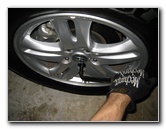 Loosen Lug Nuts |
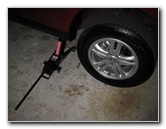 Jack Up Vehicle |
| This
automotive "how-to" guide was specifically written to assist owners
of the 2nd generation 2007, 2008, 2009, 2010, 2011 & 2012 Hyundai Santa Fe SUV in replacing
the front brake pads. Owners of other Hyundai or Kia vehicles such as the Tucson, Veracruz, Accent, Elantra, Veloster, Sonata, Azera, Genesis, Equus, Forte, Optima, Sorento, Rio, Soul, Sportage and Sedona may also find this guide to be helpful. To complete this front brake job, you'll need the following items: a floor jack, jack stands, a lug nut wrench, a 14mm socket or wrench, a "C" or "F" clamp, and a set of new front brake pads. A few compatible replacement brake pads with their part numbers are as follows: Wagner QC1432, Wagner ZD1432, ACDelco 17D1432CH, Bosch BC1432 and Raybestos PGD1432C. |
||
|
|
||
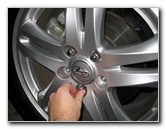 Spin Off 5 Lug Nuts |
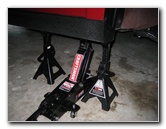 Floor Jack & Jack Stands |
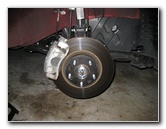 Front Brake Caliper & Rotor |
| The first step is
to use the lug nut wrench or "tire iron" to slightly loosen the
five lug
nuts on the front wheel.
(The tire iron is located under a carpeted panel in the rear of the cargo area.) Then raise the front of the vehicle with the floor jack and support it with the jack stands. Spin off the five lug nuts the rest of the way and put them aside in a safe place. |
||
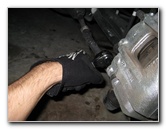 Loosen Lower Caliper Bolt |
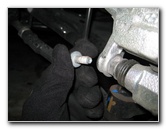 Remove Lower Caliper Bolt |
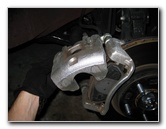 Swing Up Brake Caliper |
| Locate the lower
caliper bolt on the back side of the caliper and remove it with a 14mm
socket and ratcheting wrench. Then lift the caliper off the old pads and
rotor.
Secure the caliper to the shock tower using some twine or rope. This will keep the caliper from crashing down on your fingers or the rotor while you are replacing the brake pads. |
||
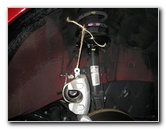 Tie Caliper To Shock |
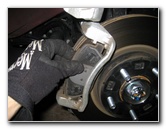 Wiggle Off Old Pads |
 Wear Bar - Inner Bottom |
| Pull the old brake
pads off the rotor and set them aside. Make a mental note of where the wear
indicator or "squeal" bar is located. On this Hyundai Santa Fe, the wear bar
was situated on the bottom of the inner brake pad. I usually buy the Wagner ThermoQuiet QC1432 brake pads since they have excellent reviews on Amazon. I also love how they don't require any backing plates or shims due to the built in insulators. As their name implies, they are quiet. Clean off the rotors, caliper and caliper bracket with some brake parts cleaner spray. To help prevent braking noise, apply some CRC Disc Brake Quiet gel or a similar product to the rear of the brake pads where they come in contact with the caliper.
The service manual torque specification for tightening the front bracket bolts is 57.9 to 72.3 lb-ft (or 78.5 to 98.1 N*m). |
||
|
|
||
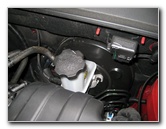 Brake Fluid Reservoir |
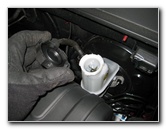 Remove Reservoir Cap |
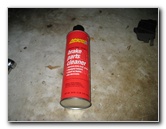 Brake Parts Cleaner Spray |
| In order for the
caliper to fit over the thicker new brake pads, the caliper piston will need
to be compressed backwards with a "C" or
"F" clamp.
First remove the cap from the brake fluid reservoir in the engine bay to allow the brake fluid to more easily travel through the brake lines when you compress the caliper piston. |
||
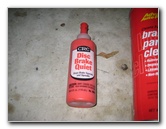 Disc Brake Quiet Gel |
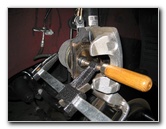 Compress Caliper Piston |
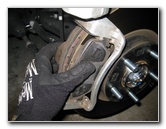 Install New Pads |
Use an old brake pad over the brake caliper piston to evenly compress the piston at a gradual pace to prevent damage. Be sure to occasionally check the brake fluid level in the reservoir while compressing the piston and avoid letting it overflow. Only compress the brake caliper piston as far back until it is flush with the rubber dust boot. Install the new brake pads into the caliper bracket with the wear indicator or "squeal" bar orientated at the bottom of the inner brake pad. |
||
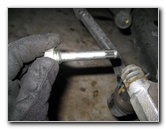 Pull Out Caliper Pins |
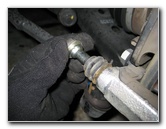 Inspect & Lubricate |
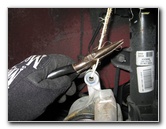 Cut Twine |
| Remove the lower
caliper pin by holding on to the rubber dust boot while pulling the pin
towards the vehicle.
If the lower caliper pin is adequately lubricated, re-insert it and also check that the upper pin moves freely by oscillating the caliper a few times. If the lower caliper pin lacked lubrication, apply some high pressure moly grease or brake caliper grease to both caliper pins. |
||
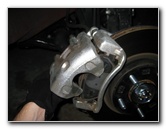 Lower Caliper Down |
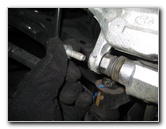 Insert Caliper Bolt |
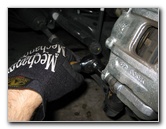 Tighten With 14mm Socket |
| Cut the twine and
carefully lower the brake caliper over the new brake pads and on to the
rotor.
If the caliper won't fit over the new pads, use the "C" clamp and an old brake pad to further compress the caliper piston. Insert the lower caliper bolt into the caliper and tighten it with the 14mm socket and ratcheting wrench to just past hand tight. If you have a torque wrench, tighten both caliper bolts to about 20 lb-ft. Note - The service manual torque specification for tightening the front caliper bolts is 15.9 to 23.1 lb-ft (or 21.6 to 31.4 N*m). |
||
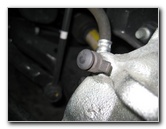 Bleeder Valve Cover |
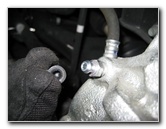 Brake Line Fluid Bleeder |
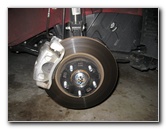 Front Brake Job Complete |
| If your brake pedal
previously felt mushy or spongy, the brake fluid may be contaminated with
water or the
brake lines may contain air bubbles.
It would be best to bleed the brake lines at this time to flush out the old fluid and replace it with new DOT 3 brake fluid. For more on this topic, check out my Brake Line Fluid Bleeding Guide. |
||
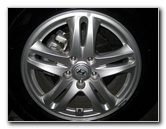 Replace Wheel & Nuts |
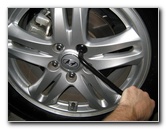 Tighten Lug Nuts |
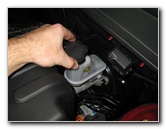 Replace Reservoir Cap |
| Replace the front
wheel and spin on the five lug nuts by hand to prevent cross threading them.
Progressively tighten the lug nuts with the tire iron in a "criss cross" or "star"
pattern. Next lower the vehicle until the tire holds some weight and complete tightening the lugs nuts. It would be best to use a torque wrench or air gun with a torque stick to tighten the lug nuts to about 80 lb-ft. Note - The owner's manual torque specification for tightening the the lug nuts is 65.1 to 79.6 lb-ft (or 88.3 to 107.9 N*m). Please double check the owner's manual to verify the correct lug nut torque specification for your specific vehicle and wheel type. Get into the driver's seat and pump the brake pedal a few times to restore brake line pressure. Then check the brake fluid level in the reservoir and verify that it is above the "MIN" (minimum) line. Once the brake fluid level is correct, replace the brake fluid reservoir cap. To break in your new brake pads, just drive normally for the first few hundred miles while trying to avoid any hard or "panic" stops. It's also a good idea to regularly inspect your driveway for drops of brake fluid which may indicate a leak, verify the brake fluid level in the reservoir, and also check that the lug nuts are still properly tightened. For more,
visit my
Hyundai Santa Fe SUV
Repair & Maintenance Guides page. |
||
| If you found this guide to be helpful,
please consider making a small donation by clicking on the PayPal.com
"Donate" button located to the right of this paragraph. Thank you!
(Note: I am not a registered charity. Donations are not tax deductible.) |

